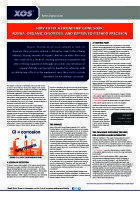Analytical Instrumentation
How to Fix a Friendship Gone Sour Russia Organic Chlorides and Improved Method Precision
Jan 28 2020
Author: Holly Dunn, Marketing Associate on behalf of XOS
Chlorine-contaminated crude oil poses dangers such as the creation of hydrochloric acid, which causes corrosion in refining equipment and pipelines. To avoid these pitfalls, refineries and terminals throughout the world have adopted ASTM D4929C and have implemented a test frequency of every four hours. ASTM D4929C uses XRF (X-ray Fluorescence) to measure the levels of chlorine content in crude, and is a fast, easy, and precise process compared to alternate methods like ICP.
Read our whitepaper to learn about a viable solution that allows refineries to obtain organic chloride concentrations in crude oil with increased precision and efficiency.
Digital Edition
PIN 25.1 Feb/March
March 2024
In This Edition Safety - The technology behind the ION Science Tiger XT - Safety with ammonia and LOHCs as hydrogen carriers Analytical Instrumentation - Discussion on new tribology te...
View all digital editions
Events
Apr 22 2024 Hannover, Germany
Apr 22 2024 Marrakech, Morroco
Apr 22 2024 Muscat, Oman
Apr 22 2024 Rotterdam, Netherlands
Apr 23 2024 Singapore















